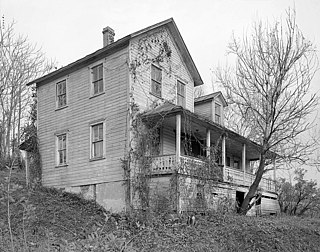
The Breakneck Road Historic District is a rural agricultural landscape near Flintstone, Allegany County, Maryland. The farms and their associated lands have remained in the possession of a small number of families since the time of their settlement.

The Shaw Mansion is an Italianate style house in the George's Creek Valley of Allegany County, Maryland, built in 1872. The house is significant as an unusually large and well-preserved example of the style for its area, with stone trim, detailed brick bonding, cast-iron mantels and much of the original interior woodwork.
The Borden Mines Superintendent's House was built in 1850 in Frostburg, Allegany County, Maryland. The Italianate style villa was built for Albert C. Green, first superintendent of the Borden Mining Company, one of the oldest mining companies in the United States. The frame house, with its three-story tower was one of the first of this style to appear in Allegany County.
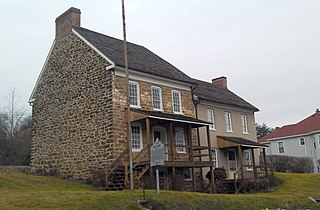
Michael Cresap House is a historic home in Oldtown, Allegany County, Maryland, USA. It is a 2+1⁄2-story, two-part stone and brick house built about 1764. The house is associated with Captain Michael Cresap (1742–1775), a well known Ohio frontiersman.

George Truog House is a historic home in Cumberland, Allegany County, Maryland, United States. It is a 3-story brick structure built in 1903. The house was designed by local architect Wright Butler, and built by George Truog, proprietor of the Maryland Glass Etching Works in Cumberland from 1893 to 1911. It contains a unique collection of decorative glass.
Hocking House is a historic home in Frostburg, Allegany County, Maryland, United States. It is a 2+1⁄2-story, three-bay, hip-roofed dwelling, built about 1855 in the transitional Greek Revival-Italianate architecture style. The land on which the home stands was part of the estate of Robert Clarke, Sr., one of the original settlers of the area that is now Frostburg. It was converted into a clubhouse in 1942.

Union Grove Schoolhouse is a historic one-room school building in Dickens, Allegany County, Maryland. It is a one-story frame building, rectangular in plan, containing a single classroom and an entrance vestibule. It is the last remaining one-room schoolhouse on its original site and in unaltered condition in Allegany County.
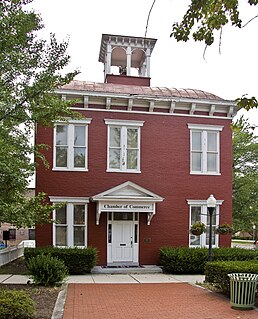
Bell Tower Building, or the Allegany County League for Crippled Children building, is a historic building in Cumberland, Allegany County, Maryland. It was built in 1887 and is a two-story brick structure topped by a small wooden tower with an open belfry. This was the first separate building to be used as police headquarters and jail in Cumberland.
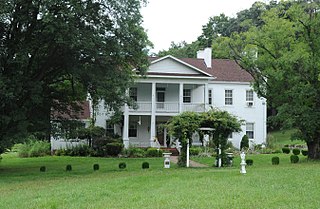
Phoenix Mill Farm, historically known as Mill Run Farm, is a historic home located in Dickens, Allegany County, Maryland, United States. It is a 2+1⁄2-story Flemish bond brick structure showing Greek Revival style influences built about 1845. It has a gable roof and double flush chimneys. On the property is the site of Smouse Mill. The home was erected for John Jacob Smouse, who operated the mill.

The Waverly Street Bridge, also called the Westernport Bowstring Arch Truss Bridge, was a historic steel bowstring truss bridge at Westernport, Allegany County, Maryland, United States. It carried vehicular traffic on Waverly Street over George's Creek. The bridge had a span length of 108 feet (33 m). It was built in 1892, by the King Bridge Company of Cleveland, Ohio.
The Shawnee Old Fields Village Site, is an archaeological site near Oldtown in Allegany County, Maryland. The site contains Late Woodland and Contact period artifacts. An area between the site and the river's edge may be the location of a number of short-term camps and/or dwelling units. The first confirmed archeological manifestation of the several historically documented Shawnee villages in Maryland. It is believed to have been the home of Chief Opessa Straight Tail, a Shawnee leader.

The Chapel Hill Historic District is a national historic district in Cumberland, Allegany County, Maryland. It is a mixed-use historic district of 810 contributing resources on 145 acres (0.59 km2) located on the southeast side of Cumberland. It contains a mix of residential, commercial, and institutional buildings, with St. Mary's Roman Catholic Church on the highest point. The vast majority of the buildings were built between 1900 and 1910, and includes an extraordinary collection of double houses built for the industrial working class of the city.

The Decatur Heights Historic District is a national historic district in Cumberland, Allegany County, Maryland. It is a mixed-use district of 77 acres (310,000 m2) located on the northeast side of Cumberland. It contains a total of 377 residential / commercial / industrial historic resources, including five properties previously listed on the National Register of Historic Places. Approximately 50 percent of the resources in the district predate 1890, approximately 40 percent date were constructed between 1890 and 1930, and the remaining approximately 10 percent post-date 1930. It is significant because: 1) its association with the history of African-American education in Cumberland; 2) its association with the exploration and settlement of the region, with its location along the National Road; and 3) the dense concentration of primarily residential buildings built between about 1820 and the 1940s.
The Frostburg Historic District is a national historic district in Frostburg, Allegany County, Maryland. It comprises 356 resources within the city of Frostburg, along U.S. Route 40, which forms the main axis of the district. Included are a collection of early-20th century commercial buildings, primarily of brick construction, two or three stories tall, and a collection of mid- to late-19th and early-20th century homes reflecting a variety of architectural styles, including Italianate, Second Empire, Queen Anne, and Colonial Revival.

The Greene Street Historic District is a national historic district in Cumberland, Allegany County, Maryland. It is a 7-acre (28,000 m2) linear historic district along both sides of Greene Street on the west side of Cumberland. It contains 45 buildings, 37 of which are residential and 8 of which exhibit commercial design characteristics. The earliest buildings in the district are built in the Federal style, followed by buildings erected in the Greek Revival, Italianate, Queen Anne, and Colonial Revival styles. The earliest of the district's resources was constructed about 1820, with the most recent built about 1930.

The Washington Street Historic District is a national historic district named after George Washington in Cumberland, Allegany County, Maryland. It is an approximately 35-acre (140,000 m2) residential area to the west of downtown Cumberland and consists primarily of six blocks of Washington Street. It contains large-scale 19th- and 20th-century houses representing most of the major architectural styles, including examples of Greek Revival, Italianate, Gothic, Queen Anne, Romanesque, Colonial Revival, and bungalow. Also included in the district are the 1890s Romanesque courthouse, the 1850s Greek Revival academy building, and the Algonquin Hotel. It was listed on the National Register of Historic Places in 1973.

The Lonaconing Historic District is a national historic district in Lonaconing, Allegany County, Maryland. It comprises 278 buildings and structures consisting of a variety of 19th and early-20th century commercial, industrial, and residential buildings. These structures identify with the development of Lonaconing as a center of the iron, coal, and silk industries in the George's Creek Valley of Western Maryland. It includes a group of 40 late-19th and early-20th century brick or frame commercial structures, including a hotel, bank, three dry goods stores, and numerous other shops and warehouses, mostly constructed after a fire which devastated downtown in 1881.
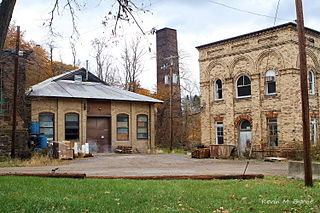
The Mount Savage Historic District is a national historic district in Mount Savage, Allegany County, Maryland. It comprises 189 19th and 20th century buildings, structures, and sites within this industrial community northwest of Cumberland. The structures reflect the community's development as a center of the iron, coal, brick, and railroad industries from the 1830s to the early 20th century. Included are a set of vertical-board duplexes on Old Row built about 1840, and possibly the earliest examples of workers' housing remaining in the region.

The Inns on the National Road is a national historic district near Cumberland, Allegany County, Maryland. It originally consisted of 11 Maryland inns on the National Road and located in Allegany and Garrett counties. Those that remain stand as the physical remains of the almost-legendary hospitality offered on this well-traveled route to the west.

Rolling Mill Historic District is a national historic district located at Cumberland, Allegany County, Maryland. It is a 38-acre (15 ha) primarily residential historic district located on the east side of the city of Cumberland. It contains a strong, locally distinctive concentration of wood and brick residences built between the early 1870s and the late 1940s. It also includes a modest commercial area. The district has a total of 173 properties, including the previously listed Francis Haley House.




















